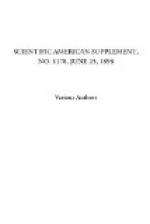The patentees and makers of this type of gear are Messrs. Croom & Arthur, Victoria Dock, Leith, who, in addition to fitting it to the three North German Lloyd steamers named in the title—which are each of 3,200 tons, having an 8-inch rudder-stock—have applied it to the Hamburg and Australian liner Meissen of 5,200 tons and 10-inch rudder stock, and to the steamer Carisbrook of 1,724 tons, owned in Leith. On the latter vessel, which was the first fitted with it, the gear has been working for over two years, giving, we are told, entire satisfaction to the owners, who say the spring buffers undoubtedly reduce the vibration when the rudder is struck by a sea, and the arrangement of quadrant and tiller appears to give increase of power. Of the installation of this gear on board the three North German Lloyd vessels, the agents of that company say: “It has been working to our entire satisfaction. This system, on the whole, proves to have answered its purpose.” Considering the advantages claimed for the gear, this is satisfactory testimony. We are indebted to The London Engineer for the cuts and description.
* * * * *
COMBINED STEAM PUMPING AND MOTIVE POWER ENGINE.
We give herewith an illustration of a compact engine, designed by Messrs. Merryweather & Sons, of London, particularly for mining work, and already supplied to the Burma ruby mines, the Salamanca tin mines, and several mining companies in Brazil and other parts of South America. It is an arrangement of the Valiant steam pumping engine with a flywheel arranged to take a belt, and is so constructed that the pump can be readily thrown out of gear and the engine used to drive light machinery. The smaller size weighs only 7 cwt., including boiler, engine and pump complete, and can be run on its own wheels, or these can be detached and the machine carried by eight or ten men on shoulder poles passed through rings fitted on top of the boiler. Thus it can be easily transported up country, and has for this reason been found most useful for prospecting. For alluvial mining it will throw a powerful jet at 100 lb. to 120 lb. pressure, or by means of a belt will drive an experimental quartz crusher or stamp mill. The power developed is six horses, and the boiler will burn wood or other inferior fuel when coal is not obtainable. The pump will deliver 100 gallons per minute, on a short length of hose or piping, and will force water through three or four miles of piping on the level, or, on a short length, 35 gallons per minute against a head of 210 feet. The pump is made entirely of gun metal, with rubber valves, and has large suction and delivery branches. Air vessels are fitted, and the motion work is simple and strong. The boiler is Merryweather’s water tube type, and raises steam rapidly, while the fittings include feed pump, injector, safety valve, steam blast and an arrangement for feeding the boiler from the main pump in case of necessity.




